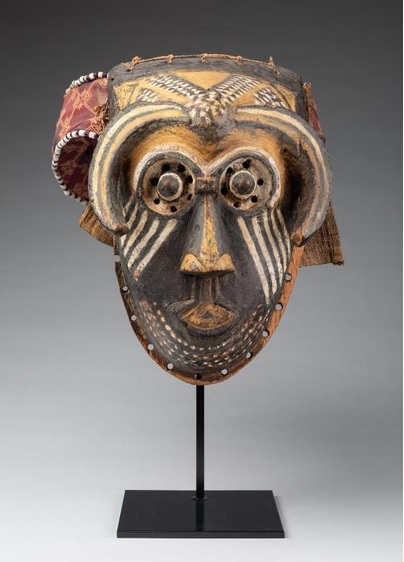
Unknown
Democratic Republic of Congo
Kuba Mask, Ishyeen Maalu, 20th c. CE, early
wood and polychrome with cloth and beads
12 3/8 × 10 1/2 × 15 1/2 in.
SBMA, Gift of the Women's Board
1969.50
RESEARCH PAPER
To understand the mask one must discuss the main purpose behind the carving of the mask which is the desire to give a real and tangible form to the spirit world as a means of gaining some control over the universal creative force. They are made as beautiful or as frightening as possible in order to get the spirit to inhabit them. Most African languages do not have a word which translates accurately as mask because the English word connotes representation when in fact the African considers the making of a mask the creation of a spirit. When a person dons the mask his personality is cancelled out and he becomes that spirit.
The Kuba are an African group found in the lower Kasai region of central Zaire [Democratic Republic of Congo]. This area consists of dense forest and savannah where the main occupation is agriculture and hunting.
The art of the Kuba has often been considered the finest of all Zaire. This observation is according to Joseph Cornet who is considered the outstanding authority on the subject. The Kuba have a strong taste for decoration which is excellently shown in this mask which is made of extensively polychromed wood, a crown of fiber cloth stretched on a form and attached to the top of the head and richly embellished with cowrie shells, beads, and cloth.
According to Cornet there are three types of royal dance masks of the Kuba and nine other non-royal dance masks. This example is called pwoom itok which is the most important type of non-royal dance mask. It is usually characterized by the bulging eyes surrounded by small holes. This mask is worn in circumcision and initiation rituals, and in this masquerade of the Kuba the mask is a tired wise old man whom the initiates come to consult. This example also has horns which classifies it as nyet. Horns traditionally signify power in African art which could possibly indicate that this mask is invested with extra power and wisdom when it consults with the other dancers in their initiation.
The geometric patterning shown in the polychrome work on the face is found throughout Kuba art. It shows up in baskets, boxes, utensils, and cloth. The Kuba are noted for their raffia pile cloth which is unique to this part of Africa.
When you consider the aesthetic sensibilities of the Kuba, their emphasis on beauty, court art and geometric pattern and design, this mask takes on a special significance as a more artistic piece than some of the other masks in the collection. One could liken this niece to assemblage which we see in much contemporary art today and which can be interpreted as a result of the collage developed by the Cubists.
The art of the mask is rich and varied and as in all African art it is a response to nature. It is a metaphor, an abstraction, an ideal, an analogy of natural images rather than an imitation of nature which is all that had been seen in Western Art since the Renaissance and is what made it so appealing to the Cubist/Expressionist artists.
Prepared for the Santa Barbara Museum of Art Docent Council by Jane Dreyfus, April 16, 1987.
BIBLIOGRAPHY
Bamert, Arnold. Africa Tribal Art of Forest and Savanna. London, England: Thames and Hudson Ltd. 1980.
Bascom, William. African Art in Cultural Perspective. New York, New York: W.W. Norton & Company, Inc., 1973.
Bleakley, Robert. African Masks. New York, New York: Gallery Books, 1978.
Segy, Ladislas. African Sculpture Speaks. 4th ed. enlarged. New York, New York: Da Capo Press, Inc. l975.
Segy, Ladislas. Masks of Black Africa. New York, New York: Dover Publications, Inc., 1976.
CATALOGUES
Institute of the National Museums of Zaire. "Art from Zaire: lOO Masterworks from the National Collection," 1975.
North Carolina Museum of Art Raleigh, North Carolina. "A Survey of Zairian Art, The Bronson Collection, 1978. Text by Joseph Cornet.
Museum of Cultural History, University of California, Los Angeles, I Am Not Myself: The Art of African Masquerade, 1985.
SBMA CURATORIAL LABELS
This mask, part of a trio, represents a warrior and is danced by members of the Babende initiation society at funerals of its members. The projecting eyes are said to resemble those of a chameleon, with holes surrounding that allow the wearer limited vision as he (always a male) dances. The cheek stripes are said to be “mournful tears” shed at the funeral honoring a deceased society member. Feathers that decorated the top of the mask are missing, as is the elaborate costume of layered raffia cloth and the dance wands held in each hand. Ishyeen Maalu dances vigorously, with high kicks and expressive pantomime gestures down the village avenue and before the community elders and in front of the corpse of the deceased man.
- Ludington Court Reopening, 2021
